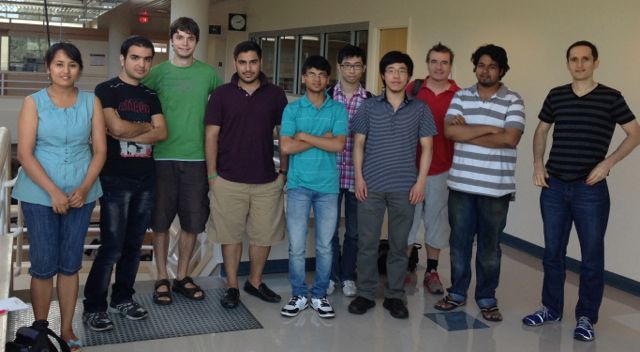Graduate Students Supervised by David Poole

Sanjana, Mehran, Matt, Mehrdad, Anuj, William, Charles, David, Anupam,
David, July 2013.
Ph.D.
- Matthew Dirks, Machine
learning for spectroscopic data analysis : challenges of limited
labelled data, 2023.
- Bahare Fatemi, Representation
learning with explicit and implicit graph structures, 2023.
- Seyed Mehran Kazemi, Representing and learning relations and
properties under uncertainty, 2018
- Mark
Crowley, 2011, Equilibrium policy gradients for spatiotemporal planning
- Michael Chiang, 2011,
Learning latent theories of relations and individuals
- Jacek Kisynski, 2010, Aggregation and Constraint Processing in Lifted Probabilistic Inference
- Rita Sharma,
2006, Probabilistic Inference with Large Discrete Domains.
- Rubén Morales-Menéndez, 2003, Real-time Monitoring
and Diagnosis in Dynamic Systems Using Particle Filtering Methods,
(Ph.D. from ITESM)
co-supervised with Nando
de Freitas.
- Carl
Alphonce, 2000, A parsing explanation of linear movement asymmetry
in natural language. Co-supervised with Henry Davis.
- Michael
Horsch, 1998, Flexible
Policy Construction by Information Refinement.
- Andrew Csinger, 1995, User
Models for Intent-based Authoring, co-supervised with Kelly Booth.
- Runping Qi, 1994, Decision Graphs: Algorithms and Applications to
Influence Diagram Evaluation and High-Level Path Planning Under
Uncertainty.
- Nevin
Lianwen Zhang, 1994, A Computational Theory of Decision Networks
- Julian
Craddock, 1993, Making Predictions Directly from Past Experiences
- Yang
Xiang, 1992, Miltiply Sectioned Bayesian Belief Networks for Large
Knowledge-Based Systems: An Application to Neuromuscular Diagnosis,
co-supervised with Michael Beddoes.
- Pierre Gaboury, 1990, VLSI Architecture Design Using Predicate
Logic, co-supervised with M.I. Elmasry
- Paul Van Arragon, 1990, Nested Default Reasoning for User
Modelling
- Eric Neufeld,
1988, Construction of a Sound Nonnumeric Probabilistic Reasoner,
co-supervised with Romas Aleliunas.
M.Sc.
- Melika Farahani, Transporting and
Evaluating Predictive Models in Different Environments., 2022
- Wan Shing Martin Wang, Hierarchical structure and ordinal
features in class-based linear models, 2021
- Ali Mohammad Mehr,
Prediction
and anomaly detection in water quality with explainable hierarchical
learning through parameter sharing, 2020
- Ainaz Hajimoradlou, Predicting
landslides using contour aligning convolutional neural networks, 2019
- Mohammad Amin Aghaee Rad, Machine learning of lineaments from
magnetic, gravity and elevation maps, 2018
- Adnan Reza, essay, 2019
- Bahare Fatemi, 2017, Finding
a Record in a Database
- Anupam Srivastava, Modeling
ordinal data for recommendation system, 2014.
- Seyed Mehran
Kazemi, 2014, Relational logistic regression
- Matthew Dirks, 2014, Sensing and sorting ore using a relational influence diagrams
- Sanjana Bajracharya, 2014, Interactive
visualization for group decision-making. Cosupervised with
Gunilla Öberg
- Anupam Srivastava, 2014, Modeling ordinal
data for recommendation systems
- Chia-Li (Charles) Kuo, 2013, Probabilistic reasoning with undefined properties in ontologically-based belief networks
- Disha Al Baqui, 2007, Value-focused GAI network structure elicitation given a domain
Ontology, co-supervised with Giuseppe Carenini.
- James Cook, 2007, Mechanism Design and Veto
Mechanisms for Sequential Meeting
Scheduling (essay).
- Mark Crowley, 2005,
Shielding against conditioning side effects in graphical models.
- Oxana Chakoula, 2002, Predicting Users' Next Access to the Web
Server
- Leslie Tung, 2002, A Clique Tree Algorithm Exploiting Context
Specific Independence
- Rita Sharma,
2001, Symmetric Collaborative Filtering using the Noisy Sensor Model
- Peter Gorniak,
2000, Keyhole State Space Construction with Applications to User
Modelling
- Carl
Alphonce, 1992, Towards and Explanatory Division of Competence and
Performance: A Language-Independent Parsing Scheme, co-supervised with
Henry Davis.
- Michael
Horsch, 1990, A dynamic approach to probabilistic inference
using Bayesian networks
- Andrew Csinger, 1990, Implementing a Normative Theory of
Communication in a Framework for Default Reasoning..

